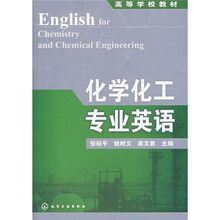Contents
Part A Descriptive Short Articles
1. Chemistry:A Science for the TwentyFirst Century
2. What is Chemical Engineering?
3. Applications of Inorganic Chemistry
4. The Map of Organic Chemistry
5. Introduction to Analytical Chemistry
6. What is Physical Chemistry?
7. Introduction to the Nanotechnology
8. A Green Chemistry Module
9. Combinatorial Chemistry:A Strategy for the Future
10. The Expression of Life
11. How to Keep a Laboratory Notebook
12. A Guide to Writing in Chemistry
13. Searching Chemistry Resources on the Internet
Part B Basic Knowledge of Chemical Engineering
1. Chemical Engineering
2. The Difference between Engineering and Science
3. Pipe Lines
4. Valves
5. Centrifugal Pump
6. Cyclone Separators
7. Cooling Towers
8. Membranes
9. Reverse Osmosis
10. Diffusion Processes
11. Simulation of Chemical Process
12. Filtration
13. Evaporation
14. Crystallization
15. Drying
16. Mixing
17. Distillation
18. Adsorption
19. Reciprocating Compressors
20. Batch and Continuous Processes
21. Continuity Principle in Steady State Processes
22. Removal of Dust from Gases
23. Centrifugal Settling Processes
24. Heat Transfer
25. Heat Exchangers
26. Single and Multipleeffect Evaporation Operation
27. Crystallization Equipment
28. Extraction
29. Liquidliquid Extraction
30. Fluidization
31. The Phenomenon of Fluidization
32. Applications of Size Reduction
33. Size Reduction
34. Characterization of Solid Particle
35. Screening
36. Instrumentation and Control
37. Supercritical Fluids(SCFs)
38. Supercritical Fluid Extraction(SFE)
39. The Material Balance
40. The Energy Balance
41. The Ideal Contact(the equilibrium stage model)
42. Rates of an Operation(the rate of transfer model)
43. Application of Computers in Chemical Engineering
44. Chemical Manufacturing Process
45. Biotechnology
46. Bioengineer
47. Genetic Engineering
48. Tissue Culture
49. Cloning
50. Fermentation Technology
Part C Intensive Articles of Chemistry
1. Introduction of General Chemistry
2. Atomic and Molecular Structure
3. Matter States
4. Chemical Reaction and Equilibrium
5. The Classification of the Elements
6. Chemical Bond and Bonding Theory
7. Brsted Acids and Bases
8. Structure and Nomenclature of Hydrocarbons
9. Aromatic Compounds
10. Type of Organic Chemical Reactions
11. Working in the Lab
12. Basic Laboratory Apparatus and Manipulation
13. High Performance Liquid Chromatography and Capillary Electrophoresis
14. Structure Determination
15. Briefing on Chemical Thermodynamics and Chemical Kinetics
16. Electrochemistry and Nuclear Chemistry
17. Colloid
18. Ceramics
19. Biomaterials: Body Parts of the Future
Part D Chemistry Glossaries
1. General Chemistry
1.1 Atoms,Elements and Ions
1.2 Electrons in Atoms
1.3 Gases,Liquids and Solids
1.4 Solutions
1.5 Reactions in Solutio
2. Inorganic Chemistry
2.1 The Periodic Table
2.2 Chemical Bonds
2.3 Redox Reactions
2.4 Simple Compounds
3. Organic Chemistry
3.1 Organic Chemistry
3.2 Polymer
4. Analytical Chemistry
4.1 Basic Terms
4.2 Base Unit
5. Physical Chemistry
5.1 Energy and Chemical Change
5.2 Reaction Rates
5.3 The Quantum Theory
6. Other Related Chemistry
6.1 Consumer Chemistry
6.2 Environmental Chemistry
6.3 Biochemistry
Part EAppendix
Appendix Ⅰ IUPAC Names and Symbols of Elements
Appendix Ⅱ Laboratory Equipment
References

 缺书网
缺书网 扫码进群
扫码进群






